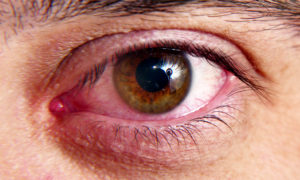By Brian Chou, OD,  FAAO
FAAO
Dec. 9, 2015
Patients often have misguided beliefs, ranging from how their vision and eye health work, to how the instrumentation in your office functions, and for what purpose. The question for doctors is whether it is more beneficial to correct the patient by educating them, or whether you should just let it go, and proceed with your exam.
Correct an issue that’s trivial and the patient may feel like you’re just showing off your knowledge without trying to mindfully help. Yet allowing certain misconceptions to slide can compromise what’s best for your patient. Discerning what’s important to correct is an art which gets better with clinical experience. As if it’s not already difficult enough, our industry also fabricates misconceptions to juice the sale of ophthalmic product.
In his book Outliers, Malcolm Gladwell contends that it takes about ten thousand hours of practice to master a field, whether it’s computer programming, playing violin, or something else. Ten thousand hours is about five years of putting in 40 hours per week. In my 16th year of practice, I feel that the expanse, depth and continual changes of our profession make optometric mastery a continual pursuit.
That said, with enough experience comes a sixth sense of anticipating our patients’ concerns. It’s like how Google auto-suggests the most common queries for each search term. In the same way, we learn to anticipate certain patient behaviors and concerns based on our cumulative experience. It is in the details of what our patients do and say that help us decide the best approach.
It’s noticing the little things, like the patient madly cleaning their glasses before reading the eyechart, as if doing so will make a big difference in the outcome (it won’t). During auto-refraction, some patients express concern that the hot-air balloon target never clears up entirely as if the instrument malfunctioned (it’s supposed to remain blurry). Or during frequency doubling perimetry, patients complain that their second eye has more difficulty seeing the visual stimuli (normal Troxler fading). Some patients will quietly hold their breath during tonometry believing it’ll give a more accurate reading (nope).
Other patients during refraction press tightly against the phoropter lenses trying to get a good result, but instead fog up the lenses, confounding the outcome. In these situations, you or your staff can put the patient at ease by noticing and acknowledging these things and then guiding them in the right direction. For example, some patients during refraction express concern that both lens choices are blurry so I’ll say, “It’s OK for both choices to look poor… but between the two, which is best?” It often takes experience to recognize these situations. Without guidance, some of these patients develop anxiety that they’ll end up with thick, ugly glasses, or “fail” an important test. I believe these patient misconceptions are important to identify and correct in order to maintain a positive and comfortable exam experience.
There are many other common patient misconceptions. For example, presbyopes frequently mistakenly refer to progressive lenses as “Transitions” lenses. LASIK patients sometimes claim that before their surgery they were “legally blind” without glasses, which is nonsensical because “legal blindness” by definition requires looking through the best optical correction. Contact lens wearers that request lenses for “extended wear” often aren’t seeking continuous wear, but lenses that they can re-use for a longer period of time. Patients who come in saying they’re “color blind” generally do not see in black and white, but are almost always color-deficient. All these misconceptions I believe are fairly low stakes, so I sometimes will not correct them, especially if they detract from more important clinical issues.
Then there are the higher-stakes misconceptions. Around Halloween, some patients ask for “non-prescriptive” costume contact lenses not realizing that all contacts are prescriptive. In these cases, I take the time to establish that professional services are desirable and necessary for a safe wearing experience. There are patients who will not use their glasses fearing that using them makes them more dependent on them. Here, I acknowledge that their personal beliefs are not unique, but at the same time there is no compelling science-based evidence to support their beliefs.
I also discuss how the benefits of good vision correction, whether for academics, occupation or athletics, greatly outweighs any unproven concerns. When correcting these misconceptions, I tend to take a gentle approach. It’s not about paternalism, or showing a position of superior knowledge. Rather, it’s about having compassion to educate the patient on what’s best for their situation, recognizing that they are often expressing vulnerability in making requests or describing a problem.
Finally, there are instances where members of our industry have created and perpetuate fake diagnostic terminology to drive product sales. In the pharmaceutical world, it’s called “disease mongering” – taking a common symptom and elevating it to the level of disease to drive drug sales.
Take for example, “Computer Vision Syndrome,” and “Digital Eye Strain.” To the consumer, these terms sound fancy and technical, and they may resonate with a bevy of non-specific symptoms. Yet these are not diagnostic, but a wastebasket catch-all name with no ICD-10 code, no different from how “pink eye” could be allergic, bacterial, viral, uveitic, dry eye, or even a foreign body. The danger in condoning use of pseudo-terminology is that it undermines our credibility and efforts to fully integrate into medical eyecare. There are already enough patient misconceptions in eyecare that it doesn’t seem right to facilitate the addition of more of them.
When a patient expresses a false concern or assumption, weigh the benefits of correcting them versus not belaboring a point that isn’t important, and may alienate them in the process. If correcting the patient will improve their vision, eye health, or peace of mind, don’t hesitate to (gently) set them straight.
What is your approach to managing patient misconceptions? Do you reflexively always correct, regardless of how important or unimportant the point, or do you sometimes let it go? Why?
Brian Chou, OD, FAAO, is a partner with EyeLux Optometry in San Diego, Calif. To contact him: chou@refractivesource.com.



























